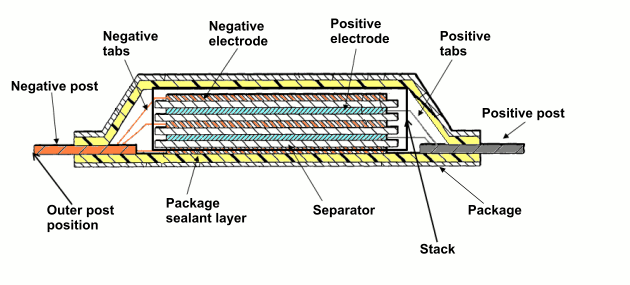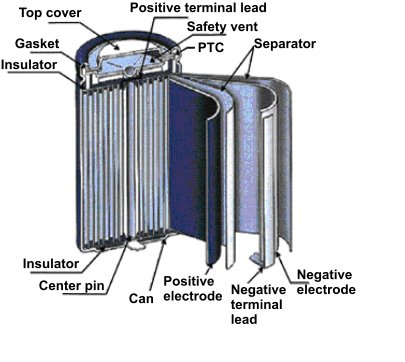Batteries
You can simulate batteries in Simcenter STAR-CCM+ using battery cells and battery cycling procedures that are defined either directly in Simcenter STAR-CCM+, or in the external software package Simcenter Battery Design Studio.
Battery Structure Terminology
A battery cell is a single unit that is used to store energy. You can model two types of battery cells in Simcenter STAR-CCM+: stacked cells and cylindrical spiral cells. Each cell type is associated with its own basic terminology.
- Stacked Cells
-

- Cylindrical Spiral Cells
-

- Electrodes
- The cell components that conduct the electrochemical reaction (every electrode has a tab). Electrodes are comprised of coating on a metal foil. The positive electrode is typically a metal oxide or metal phosphate on an aluminum foil while the negative electrode is typically a graphite paste on copper.
- Separator
- A layer that is made of non-conductive material that keeps two electrodes separated, thus preventing a short-circuit. A separator allows ionic transport
- Tabs
- Flat connectors that protrude from each electrode.
- Stack
- The electrodes and separators within the battery cell, excluding tabs.
- Package/Can
- An outer layer that is used to house cell components.
- Package Sealant Layer
- The layer that contains the active chemicals.
- Posts
- The parts that connect electrode tabs to other conducting objects, such as another battery cell (also known as busbars).
- Terminal Leads
- Current collectors from either the positive or negative electrode to the can.
- Center pin
- A support that is left in the core of a spiral cell to support its shape, typically made of steel or plastic.
- Insulators
- Typically polyolefin disks that are used to prevent the ends of the jellyroll from touching the bottom or top of the package.
- Gasket
- An insulating sealant material that is used to electronically isolate the top cover from the can.
- Top Cover
- A top cover for the package, typically made of nickel plated steel.
- Safety Vent
- A rupture disk that is used to release pressure.
- PTC
- Positive Temperature Coefficient device that is put in series between the positive terminal lead and the top cover. The electrical resistance of the PTC greatly increases with temperature. In this way, it functions as a safety device that prevents current flow when the battery is hot, and limits high currents that can heat up the PTC.
Licensing Requirements
For battery pack electro-thermal simulations, Simcenter STAR-CCM+ requires a batterysim license in addition to the other license features.
Simcenter Battery Design Studio which is supplied for use with the Simcenter STAR-CCM+ battery modeling capability, requires a batterydesignstudio license.
The batterysim license cannot be used for Simcenter Battery Design Studio.